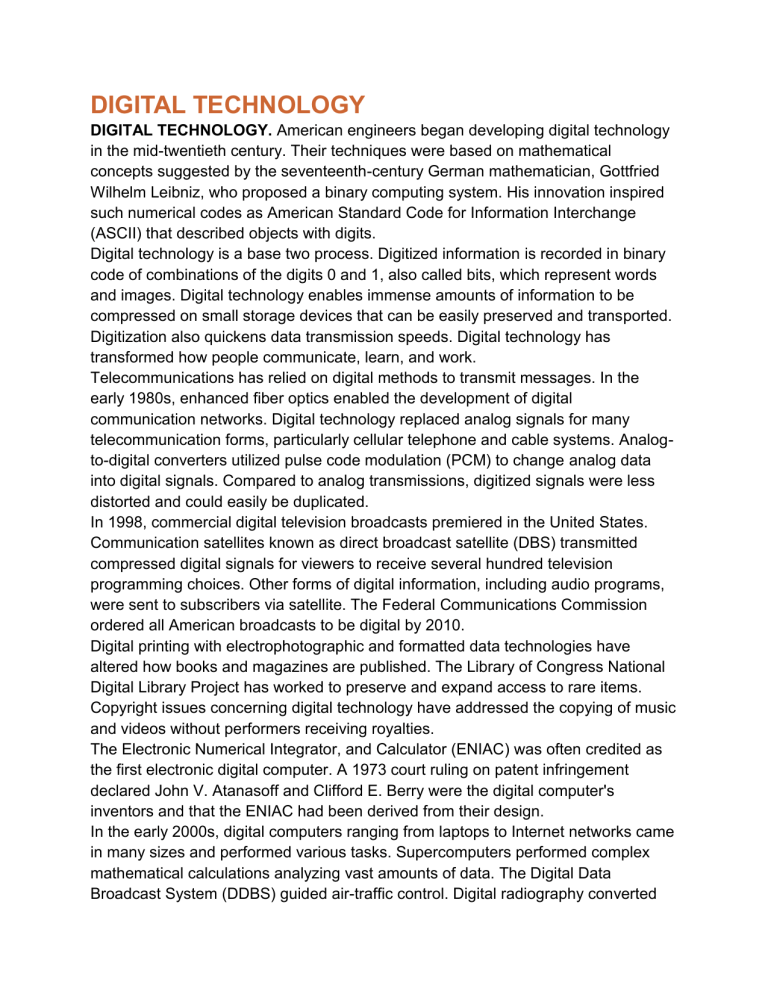
DIGITAL TECHNOLOGY DIGITAL TECHNOLOGY. American engineers began developing digital technology in the mid-twentieth century. Their techniques were based on mathematical concepts suggested by the seventeenth-century German mathematician, Gottfried Wilhelm Leibniz, who proposed a binary computing system. His innovation inspired such numerical codes as American Standard Code for Information Interchange (ASCII) that described objects with digits. Digital technology is a base two process. Digitized information is recorded in binary code of combinations of the digits 0 and 1, also called bits, which represent words and images. Digital technology enables immense amounts of information to be compressed on small storage devices that can be easily preserved and transported. Digitization also quickens data transmission speeds. Digital technology has transformed how people communicate, learn, and work. Telecommunications has relied on digital methods to transmit messages. In the early 1980s, enhanced fiber optics enabled the development of digital communication networks. Digital technology replaced analog signals for many telecommunication forms, particularly cellular telephone and cable systems. Analogto-digital converters utilized pulse code modulation (PCM) to change analog data into digital signals. Compared to analog transmissions, digitized signals were less distorted and could easily be duplicated. In 1998, commercial digital television broadcasts premiered in the United States. Communication satellites known as direct broadcast satellite (DBS) transmitted compressed digital signals for viewers to receive several hundred television programming choices. Other forms of digital information, including audio programs, were sent to subscribers via satellite. The Federal Communications Commission ordered all American broadcasts to be digital by 2010. Digital printing with electrophotographic and formatted data technologies have altered how books and magazines are published. The Library of Congress National Digital Library Project has worked to preserve and expand access to rare items. Copyright issues concerning digital technology have addressed the copying of music and videos without performers receiving royalties. The Electronic Numerical Integrator, and Calculator (ENIAC) was often credited as the first electronic digital computer. A 1973 court ruling on patent infringement declared John V. Atanasoff and Clifford E. Berry were the digital computer's inventors and that the ENIAC had been derived from their design. In the early 2000s, digital computers ranging from laptops to Internet networks came in many sizes and performed various tasks. Supercomputers performed complex mathematical calculations analyzing vast amounts of data. The Digital Data Broadcast System (DDBS) guided air-traffic control. Digital radiography converted analog signals of x-rays to create digital images. Digital information was stored on plastic disks with pitted patterns of 1s and 0s that lasers translated. By the early 2000s, digital cameras had transformed photography by recording color and light intensities with pixels. Also, digital compression of images and video was achieved by Joint Photographic Experts Group (JPEG) and the Moving Picture Experts Group (MPEG) codes. Animation had often been digitized with some films and cartoons being created entirely with computers. Digital describes electronic technology that generates, stores, and processes data in terms of two states: positive and non-positive. Positive is expressed or represented by the number 1 and non-positive by the number 0. Thus, data transmitted or stored with digital technology is expressed as a string of 0's and 1's. Each of these state digits is referred to as a bit (and a string of bits that a computer can address individually as a group is a byte). Prior to digital technology, electronic transmission was limited to analog technology, which conveys data as electronic signals of varying frequency or amplitude that are added to carrier waves of a given frequency. Broadcast and phone transmission has conventionally used analog technology. Digital technology is primarily used with new physical communications media, such assatellite and fiber optic transmission. A modem is used to convert the digital information in your computer to analog signals for your phone line and to convert analog phone signals to digital information for your computer.
